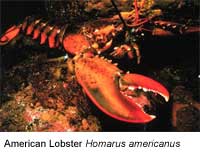|

 Lobsters are invertebrates, and have a tough exoskeleton, which
protects them. Like all arthropods, lobsters must molt in order
to grow, leaving them vulnerable during this time. They're considered
a delicacy around the world, and in certain parts are extremely
expensive. Smaller varieties of lobsters are sometimes called "lobsterettes." Lobsters are invertebrates, and have a tough exoskeleton, which
protects them. Like all arthropods, lobsters must molt in order
to grow, leaving them vulnerable during this time. They're considered
a delicacy around the world, and in certain parts are extremely
expensive. Smaller varieties of lobsters are sometimes called "lobsterettes."
Habitat: Lobsters live on rocky, sandy, or muddy bottoms from the shoreline
to beyond the edge of the continental shelf. They generally live
singly in crevices or in burrows under rocks.
Diet: Although many studies suggested that lobsters are primarily scavengers,
feeding on mollusks and decaying animal matter, recent studies have
shown that they primarily feed on live fish, dig for clams, sea
urchins, and feed on algae and eel-grass. They occasionally eat
other lobsters, too. An average adult lobster is about 230 mm (9
inches) long and weighs 700 to 900 g (1.5 to 2 pounds). Lobsters
grow throughout their lives, though, and are long-lived. They can
thus reach impressive sizes. According to the Guinness World Records,
the largest lobster was caught in Nova Scotia, Canada and weighed
20.14 kg (44.4 lb).
Bilaterally symmetrical: Like all arthropods, lobsters are bilaterally symmetrical; clawed
lobsters often possess unequal, specialized claws, like the king
crab. The anatomy of the lobster includes the cephalothorax which
is the head fused with the thorax, both of which are covered by
the carapace, and the abdomen. The lobster's head consists of antennae,
antennules, mandibles, the first and second maxillae, and the first,
second, and third maxillipeds. Because a lobster lives in a murky
environment at the bottom of the ocean, its vision is poor and it
mostly uses its antennae as sensors. The abdomen of the lobster
includes tiny swimmerets, which assist with mobility in the water.
Movement: In general, lobsters move slowly by walking on the bottom of the
sea floor. However, when they are in danger and need to flee, they
swim backwards quickly by curling and uncurling their abdomen. A
speed of 5 meters per second has been recorded.
All text is available under the terms
of the GNU Free Documentation License
|